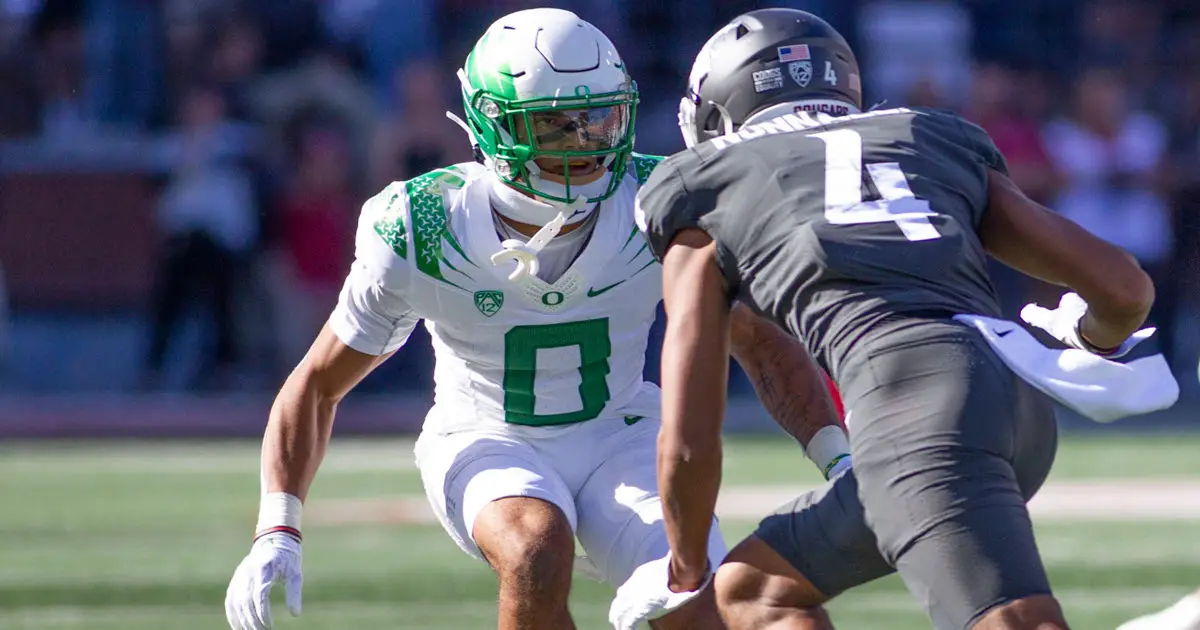Many Duck fans were surprised by the Wazzu defense, as they seemed to be faster than the Ducks, getting into the backfield and blowing up plays. Fans’ observations that two defenses appeared different were correct: they are two different pass defense schemes.
Both teams run a 4-2-5 scheme for the most part. This defense consists of four men on the defensive line, two linebackers, and five defensive backs. The Cougars seem to always be in a Cover-1 defense with one deep safety, while the Ducks mostly play a Cover-2 with two deep safeties.
Havoc Defense
The basics of the Cover-1 Wazzu is running puts the defensive backs in man-to-man coverage except for the deep safety. The deep safety’s job is to play deep and react to the play. The benefit of Cover-1 is that it gives the defense another defender closer to the line of scrimmage. This allows them to flood more players into power runs and sweeps. The extra man also helps in getting numbers into the play when defending screens and short crossing routes. (As we saw, the Cougars really swarmed those plays at times). I often saw the Cougars stack eight defenders in the box against the Ducks.
Defenses in basic Cover-1 pre-snap identify their man-to-man coverage assignments, and they do not change assignment. The Cover-1 the Cougars play is part of the reason they look so fast getting defenders into covering screens and why it’s hard to run lateral plays against them. The extra defender up closer to the line of scrimmage is what makes all pf that happen. Inside the 10-yard line, where the field is even more condensed, Oregon really struggled running lateral plays against the Cougars.
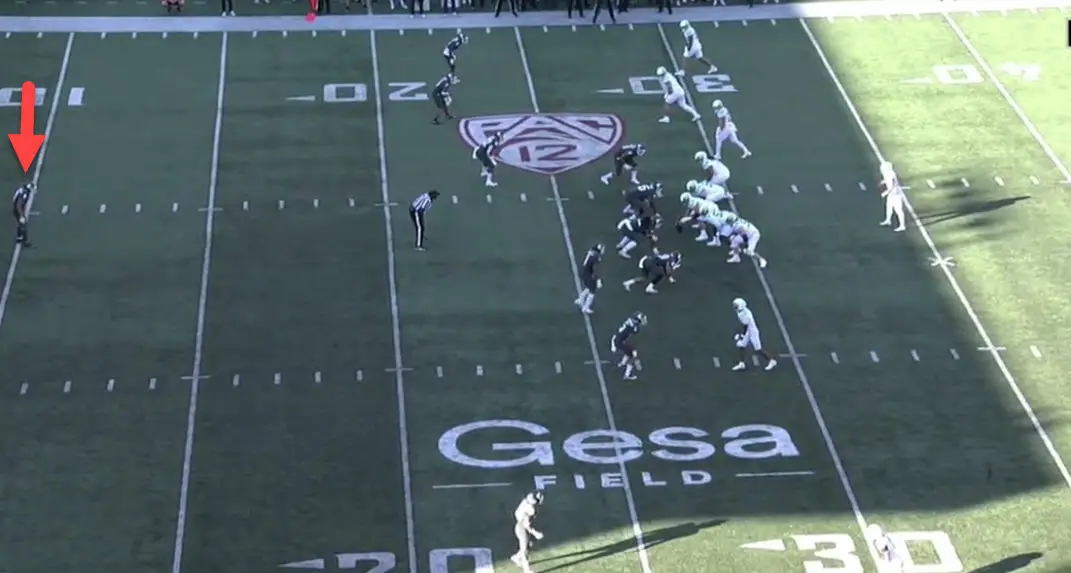
Washington State with their riskier one-high safety.
All or Nothing
The weakness of the Wazzu Cover-1 defense is with the man-to-man coverage defending the mid-range to deep passing game. Bo Nix and the Ducks wide receivers shredded the Cougars with mid-range crosses and deep balls.
Wazzu is as aggressive with their defensive scheme as any team I’ve seen, and one play sums up how risky the Cougars play. That play was the 50-yard TD Nix threw to Troy Franklin with 1:21 to play in the game. The Cougars were in a do-or-die defensive call.
The Ducks came to the line in an empty set with five wide receivers. With a five-point lead, instead of playing a conservative prevent defense, the Cougars put six men on the line of scrimmage, and five defensive backs in man-to-man coverage. Four of the cougars DBs were five yards off the line of scrimmage and the fifth DB was eight yards off the line.
The Cougars were gambling, all in — playing Cover-Zero with no deep safety! Wazzu lived and died by the sword!
I suspect the Cougars run so much Cover-1 to make up for the talent and size they lack. They don’t have a bunch of blue-chips and they are smaller on the defensive line. They are aggressive and sell out shooting gaps, trying to blow plays up, instead of taking on blockers and getting driven off the ball with the power run. They use that extra defender up close to the line of scrimmage to take away the lateral screens and sweeps.
It’s as if the Cougars have decided they will get picked apart with the power run, sweeps, screens, and perimeter passes if they are in Cover-2.
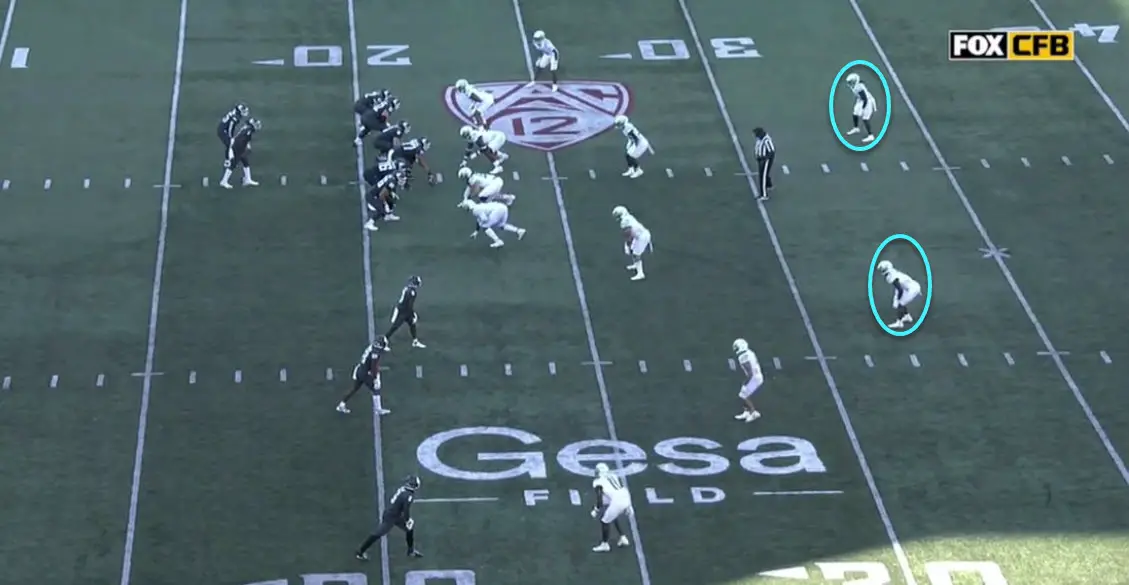
Oregon with their two high safeties.
Keep Them in Front
That brings us to the Ducks and the Cover-2 they run. We saw Georgia pick us apart with screens and perimeter passes. To defend that in Cover-2 you must quickly read the play and instantly sprint into the play. You have to strike and stand-up blockers into the play, and then disengage them. With one less defender up close to the line of scrimmage, like in Cover-1, it takes longer for the safety to run into the play.
These are all things head coach Dan Lanning and DC Tosh Lupoi have been coaching since the Georgia game. Wazzu really took it to the Ducks early in the game with the screens, and I was even wanting the Ducks to go to man-to-man in Cover-1. But the Ducks adjusted to the speed Cougars QB Cameron Ward had in getting the ball out. You started to see the cornerback standing up the WR at the line of scrimmage and setting the edge on screens. The linebackers and safeties started to run into supporting the play faster.
Though the Ducks started to stuff some of the screen game, the Cougars were hitting the quick slant in. Oregon could never really stop that all game, as it’s a weak spot in the Cover-2 that Wazzu attacked. Here again, the Ducks could have gone Cover-1 and put an extra defender up close to stop that slant. They also would have been even more effective defending screens and short crosses.
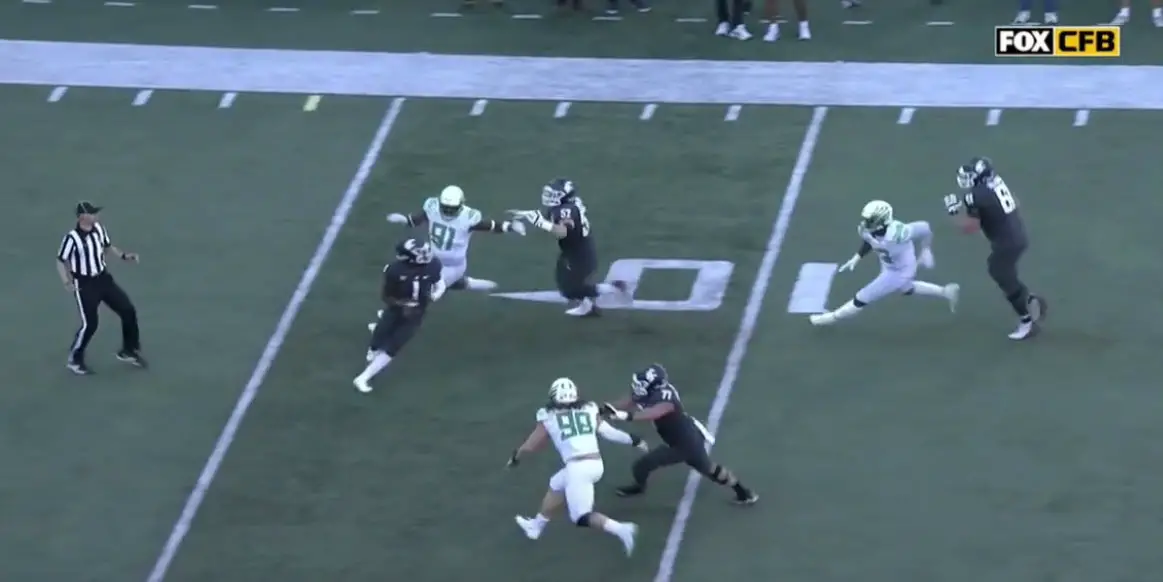
Oregon ruined plays for the Cougars just rushing four.
Lanning seems committed to the Cover-2 scheme. Oregon can get pressure rushing only four (see Charles’s analysis) and keep plays in front of them in Cover-2 with our back seven. We didn’t see the Cougars shred our defense with the deep ball. That’s because in the Oregon Cover-2, the safeties are at least 12 yards off the ball pre-snap, and they drop to each take a deep half zone to defend. The other five defenders of the back seven have to cover the screens and short crosses in a zone or man-to-man coverage. To keep this simple: we get into pattern read for the linebackers, corners, and Star (that’s another whole article).
I don’t want to make this complex. The key takeaway is that in Cover-2 the Ducks have two deep safeties to keep from getting beat on deep passes. That’s why you see teams throwing lots of screens, slants, and shallow crosses — it’s the soft spot of the defense. Oregon’s scheme is making teams have to drive the entire field to score. Oregon isn’t giving up huge chunk passing plays like the Cougars did Saturday.
Lanning’s Scheme Worked
I had some Duck fans tell me our defense was terrible and we gave up 41 points! No, the defense didn’t give up the pick six, they gave up 34 points. Wazzu did a great job on offense under OC Eric Morris. Cameron Ward ran this offense the last two years under Morris, who had mentored under Mike Leach at Wazzu, and he was OC under Kliff Kingsbury at Texas Tech from 2015-17. Morris’s offense in 2015, with Patrick Mahomes as his QB, was the No. 2 offense in FBS!
We have to give the Cougars credit for a job well done. They went with fast tempo and caught the Ducks out of position at times, and Morris called a great game. The Ducks defense forced the Cougars to punt three times. The Cougars final score came with 15 seconds left in the game, set up by a 60-yard pass with two Duck defenders in the play. The Duck’s defense was an eye lash from holding the Cougars to 27 points.
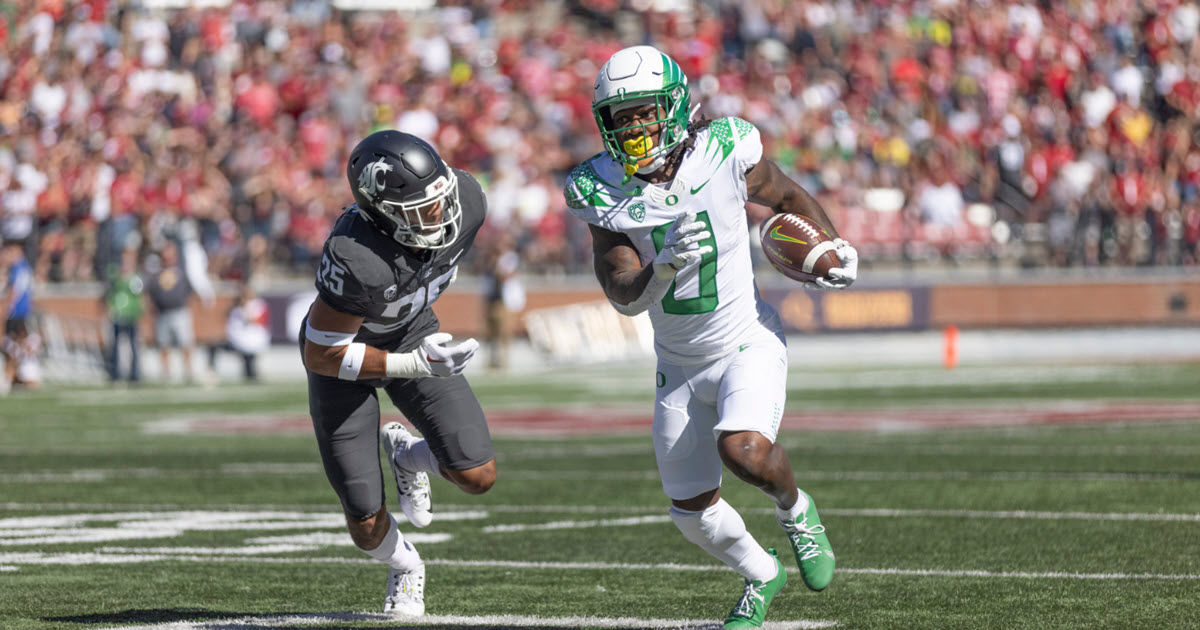
Coach Lanning has confidence in the offense scoring tons of points to align with this defensive strategy.
Lanning’s safer Cover-2 scheme saw Oregon record 4 sacks, 11 tackles for loss and 3 QB hurries. If Ward wasn’t so shifty and mobile, they would have had more sacks. In addition, Oregon had four first-half possessions in the red-zone that resulted in only 9 points. The Oregon offense left points on the field.
Lanning is running base Cover-2 and electing to get pressure with four rushers. He is making teams drive the field and avoiding big play scoring drives. It could be that Lanning trusts his offense is going to put points on the board so he doesn’t have to play a high-risk defensive style.
I don’t expect much to change with the Ducks defensive style. I think what we saw on Saturday is what Coach Lanning has decided upon for his Oregon defense in this 2022 football season.
Duck fans, please share your thoughts in the OBD FORUM!
DazeNconfused
Portland, Oregon
Top Photo by Harry Caston
 Andrew Mueller, the FishDuck.com Volunteer Editor for this article, works in higher education in Chicago, Illinois.
Andrew Mueller, the FishDuck.com Volunteer Editor for this article, works in higher education in Chicago, Illinois.

I was born a Cali kid and my uncle is a USC Alum. Remember going to an SC game when I was like 5 with him. I moved to Oregon in 77 when I was 6 and became a Duck fan long ago. I remember Reggie Ogburn OB days, so it was before the Ducks got good. I’ve been a sports nut since I was a kid.
I went to Tigard High about the same time as linebacker Jeremy Asher did, and I watched him team with Rich Ruhl on the inside of the Gang Green defense.
Lots of Ducks memories, Danny O’Neil’s passing in 1st Rose Bowl, Kenny Wheaton, Joey’s comebacks early in his career and how jacked up he got!

